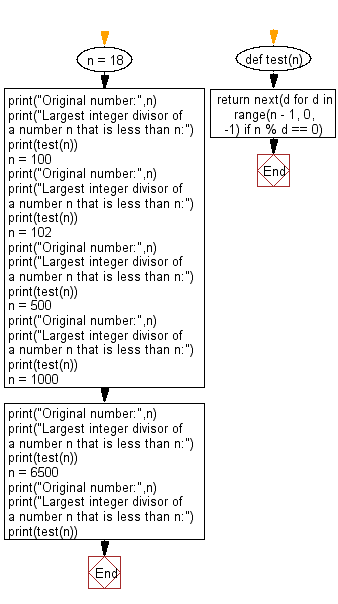Python: Find the largest integer divisor of a number n that is less than n
A divisor is a number that divides another number either completely or with a remainder.
Largest Proper Divisor
Write a Python program to find the largest integer divisor of a number n that is less than n.
Input: 18 Output: 9 Input: 100 Output: 50 Input: 102 Output: 51 Input: 500 Output: 250 Input: 1000 Output: 500 Input: 6500 Output: 3250
Visual Presentation:

Sample Solution:
Python Code:
# License: https://bit.ly/3oLErEI
# Define a function named 'test' that takes an integer 'n' as input
def test(n):
# Return the largest integer divisor of 'n' that is less than 'n'
return next(d for d in range(n - 1, 0, -1) if n % d == 0)
# Assign a specific value 'n' to the variable
n = 18
# Print a message indicating the original number
print("Original number:", n)
# Print a message indicating the operation to be performed
print("Largest integer divisor of a number n that is less than n:")
# Print the result of the test function applied to 'n'
print(test(n))
# Assign another specific value 'n' to the variable
n = 100
# Print a message indicating the original number
print("\nOriginal number:", n)
# Print a message indicating the operation to be performed
print("Largest integer divisor of a number n that is less than n:")
# Print the result of the test function applied to 'n'
print(test(n))
# Assign another specific value 'n' to the variable
n = 102
# Print a message indicating the original number
print("\nOriginal number:", n)
# Print a message indicating the operation to be performed
print("Largest integer divisor of a number n that is less than n:")
# Print the result of the test function applied to 'n'
print(test(n))
# Assign another specific value 'n' to the variable
n = 500
# Print a message indicating the original number
print("\nOriginal number:", n)
# Print a message indicating the operation to be performed
print("Largest integer divisor of a number n that is less than n:")
# Print the result of the test function applied to 'n'
print(test(n))
# Assign another specific value 'n' to the variable
n = 1000
# Print a message indicating the original number
print("\nOriginal number:", n)
# Print a message indicating the operation to be performed
print("Largest integer divisor of a number n that is less than n:")
# Print the result of the test function applied to 'n'
print(test(n))
# Assign another specific value 'n' to the variable
n = 6500
# Print a message indicating the original number
print("\nOriginal number:", n)
# Print a message indicating the operation to be performed
print("Largest integer divisor of a number n that is less than n:")
# Print the result of the test function applied to 'n'
print(test(n))
Sample Output:
Original number: 18 Largest integer divisor of a number n that is less than n: 9 Original number: 100 Largest integer divisor of a number n that is less than n: 50 Original number: 102 Largest integer divisor of a number n that is less than n: 51 Original number: 500 Largest integer divisor of a number n that is less than n: 250 Original number: 1000 Largest integer divisor of a number n that is less than n: 500 Original number: 6500 Largest integer divisor of a number n that is less than n: 3250
Flowchart:

For more Practice: Solve these Related Problems:
- Write a Python program to find the largest divisor of a given number that is less than the number itself using iteration.
- Write a Python program to determine the proper divisors of a number and select the maximum among them.
- Write a Python program to use a for-loop to test potential divisors from n//2 downwards and return the first divisor found.
- Write a Python program to compute the largest proper divisor by iterating from 1 to n-1 and checking divisibility.
Go to:
Previous: Find the largest k numbers.
Next: Sort the numbers by the sum of their digits.
Python Code Editor :
Have another way to solve this solution? Contribute your code (and comments) through Disqus.
What is the difficulty level of this exercise?
Test your Programming skills with w3resource's quiz.
